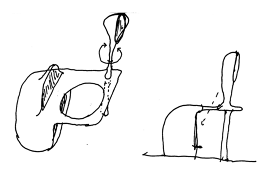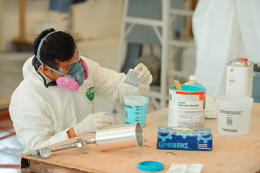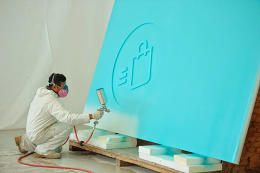From App to Architecture: How Curbside Designed And Built Its “Pickup Pod”
It’s made of fiberglass. It’s designed to be mass-produced. It’s smartphone-enabled. And someday, there could be thousands of them.
I’m standing in a cavernous, hangar-like building in American Canyon, California, 40 miles north of San Francisco in the Napa Valley. Inside the 35,000-square-foot structure is another structure—a gleaming blue-and-white kiosk whose most striking feature is a 20-foot spire topped off by a light-up panel shaped like an upside-down teardrop. I’ve never seen quite anything like it. Nor has almost anyone else: It’s the only one in the world, and it was built in secrecy by a small team inside this facility.
The kiosk’s official name is the Pickup Pod. Starting next week, it will be open for business outside the entrance of the Glendale Galleria, one of the largest malls in the Los Angeles area, where it will be tough to ignore. And if a startup called Curbside has its way, Pickup Pods will eventually sprout up on the premises of the nation’s shopping meccas like the Fotomats of an earlier era.
Curbside is the brainchild of Jaron Waldman and Denis Laprise, who partnered up while working at Apple, where they had both landed after selling location-technology startups to the company. When they hatched their new idea in 2013—with funding from investors such as Yahoo cofounder Jerry Yang—they didn’t intend to build anything other than software and a service. But Curbside sits at its own unique intersection of the physical and digital—one that logically led to the creation of the Pickup Pod.

Drive Up, Drive Away
As its name indicates, the Curbside service—which is currently available in the San Francisco Bay Area and New York/New Jersey, with the Glendale Galleria inaugurating a presence in Southern California—is about convenient pickup from real-world retailers. (The company has deals with big-box stores including Best Buy and Target, along with mall operators such as GGP, which owns the Glendale Galleria, and Westfield.) You shop in an app on your phone. In as little as 40 minutes, you can pull your car up outside a store or mall and get your stuff handed to you. You don’t even need to leave your vehicle.

Curbside competes with same-day delivery services such as Google Shopping Express, and is designed for a world in which stopping by a nearby store for anything from diapers to a flat-screen TV might be more convenient than waiting at home for a courier—as long as you don’t need to find parking, wait in line at checkout, or, you know, actually shop. It also gives retailers with major footprints in the physical world an opportunity to sell to people who are increasingly doing their shopping on smartphones.
“They’ve got this massive investment in stores on the ground which are in proximity to the population,” says Waldman, Curbside’s CEO. “As shopping is going to e-commerce and e-commerce is going to mobile commerce, how do you take advantage of that investment made in those stores, and connect shopping on mobile to stores?”
The service has many moving parts which, if everything is operating smoothly, should be invisible to the consumer. It needs to have accurate, real-time information on what’s in stock at retailers, and a mechanism for swiftly gathering items once they’ve been ordered and readying them for pickup. It uses the GPS in smartphones to alert reps that a particular customer is arriving, and must do so in a way that doesn’t kill a phone’s battery.
“When you approach the store, we use a variety of techniques—background location and other stuff—to reliably notify staff on-site that you’re coming,” says Waldman. “And that enables a really nice, very smooth handoff experience. They know you’re coming and have the bag, they can greet you by name and put the stuff in your trunk if you want. And you’re off and on your way in 20 seconds.”

Strictly speaking, one thing Curbside doesn’t absolutely require is something like the Pickup Pod. It just needs to make sure that customers know where to go when they arrive. Since the service went live last fall, its reps have been doing their work in a number of improvised setups, most notably standing under a tent akin to the ones used at soccer games.
The tent worked—just not all that well. Some shoppers couldn’t spot it across a crowded parking lot. Others didn’t immediately get that it was associated with Curbside. Even once they figured it out, it wasn’t the world’s classiest branding association. “People thought it was a limited-time offer, or maybe we were selling a credit card or something like that,” says Waldman. The tents also didn’t provide reps with any way to secure items. And wireless connectivity—which is crucial to ensuring that Curbside has your purchases ready the moment you pull up—is often spotty in parking lots.
All these factors led the company to conclude that it would make sense to devise an improvement: something permanent, easy to see, and unmistakably its own. But where do you go to find someone to create that?

A Product, Not A Building
Curbside’s search took it to Los Angeles architect Greg Lynn. He teamed with Bill Kreysler of Kreysler & Associates, a company with over 30 years of experience in fabricating massive objects out of composite materials. It was Kreysler’s facility in American Canyon where I saw the Pickup Pod in almost-finished form.

Neither Lynn nor Kreysler had ever tackled a project precisely like what Waldman and Laprise had in mind. But that was sort of the point.
“I tend to specialize in finding the right identity for somebody who has a new problem,” says Lynn, who once gave a TED Talk on a Korean Presbyterian church he designed in Queens, New York—for clients who started out mostly knowing that they didn’t want it to look like a Korean Presbyterian church. “I really try to be innovative, which is not an easy thing to do in the building industry. It’s very allergic to innovation, curiously enough.”
As for Kreysler, every job he undertakes is one of a kind. In the 1980s, he fabricated portions of the Death Star for George Lucas. For the artists Claes Oldenburg and Coosje van Bruggen, his company built giant bowling pins in the Netherlands, a dropped ice cream cone atop a building in Germany, and a bow and arrow on San Francisco’s Embarcadero. Even its projects that aren’t as exuberantly eccentric, such as the sail-like acoustic panels for a concert hall at Stanford University, are not exactly humdrum.
Lynn and Kreysler are longtime collaborators, brought together by their shared love of quirky challenges and interest in the use of digital tools such as 3D printing and CNC milling. “When Greg came to us with this thing, it was right in our wheelhouse, and we said, ‘God, we’d love to do it,'” says Kreysler. “We do whatever he tells us to do, pretty much for whatever he tells us to do it for. It’s kind of the price of admission to work with Greg.”
One thing that was clear from early on was that the team would think of the Pickup Pod more as a product than a building. If Curbside succeeds, it might need to produce tens of thousands of Pods, ship them across the country, and assemble them at stores and malls. Every extra component and production step would just complicate that process.
“When you think of a building, it’s really about assembling parts and pieces from all these different trades,” says Lynn. “Whereas if you do an industrial product, you’re really talking about designing something for its tooling and mass production. And minimizing the number of parts and the steps in assembly—all those kinds of things have an economy and a logic which in the building industry, you don’t have so much. I tried to bring an industrial-design approach to a building-scale object.”
The Pickup Pod ended up having fewer than a dozen pieces. “For an object this big, most builders would build about a thousand parts,” says Lynn. “And every one would be a little different,” adds Kreysler. Thanks to the use of fiberglass, the Pod is sturdy but weighs only 1,800 pounds, which is light enough to be an advantage when it comes to transportation.
Kreysler & Associates fabricated the Pod using techniques similar to those used in boat building—which happens to be what Bill Kreysler did in a former life. Using an enormous CNC milling machine, it produced molds for the necessary parts. Then it cast them out of fiberglass and spray-painted on the color.
The Point Of The Pin
The structure that Lynn designed feels timeless—at once evocative of roadside architecture of the past and meant to have a long enough shelf life that it won’t feel stale in a decade. From both an aesthetic and functional standpoint, it’s exceptionally streamlined. There’s a bit of lockable storage, so the rep can step away if necessary. There’s a windowed area with pegs for hanging shopping bags ready for pickup—a touch which helps to make it clear what the Pod is all about.

Oh, and there’s that 20-foot spire. Curbside calls it the Pin, in reference to the fact that its teardrop-shaped top looks like the pin icon on a digital map.
The Pin does several things. It helps hold up the kiosk’s canopy roof. It contains antennas and electronics to boost wireless reception and help the Curbside system identify customers as they approach for a pickup. Its sheer height makes the Pod easy to spot from a distance. “It’s this visual anchor,” says Waldman. “If you’re at car scale, and moving at car speed, you have to be able to pick it out.”
And just to make the Pin impossible to miss, it’s designed to light up in a personalized color for each Curbside customer—and to rotate to greet cars as they arrive. “If you’re approaching from the left side of the lot it can be facing you,” says Lynn. “If you’re approaching from the right side of the lot it can be facing you. That kind of evolved as we went along.”
The Beta Test
The first Pickup Pod is going to the Glendale Galleria because the mall’s operator, GGP, is especially eager to be part of figuring out the future of the Curbside service. “They’ve been fantastic,” Waldman says. “They loved the design immediately.”

In Glendale, the Pod will get a real-world workout and be exposed to the elements, such as they are in Southern California. “We have to think about waterproofing, about moisture intrusion, earthquake loads, wind loads,” Kreysler says. “All kinds of little things.”
Curbside will watch and learn. “We’re software people, so we wanted to build a prototype and get it out in the real world and live on it,” says Waldman. “We’ll live on this for a few months. I’m sure we’ll have more design tweaks. And then we’ll come back and do another version.”
Eventually, if all goes to plan, the company will need to produce Pickup Pods in volume. That might happen at Kreysler & Associates, but the Pods are designed to be manufacturable by other facilities if that makes sense. “We would like to [build more Pods], and we will try,” Kreysler says. “But we’ll also make sure that they’re getting the best value by helping them go out and get pricing from other vendors.”
Curbside needs to take off as a concept before there’s any chance that popping out Pickup Pods will become a major undertaking. But Waldman and Laprise, like all startup founders, are optimists. Everything about the project is based on readying the company for the day when it needs to put up mass quantities of Pods, and quickly.
“Frankly, at the volume they’re talking about, I’m not sure I want to work that hard,” says Kreysler.
[Images courtesy of Curbside]
Fast Company , Read Full Story
(184)


















